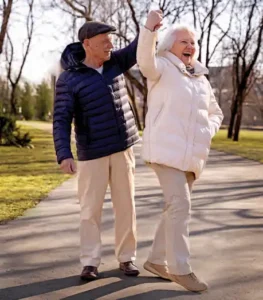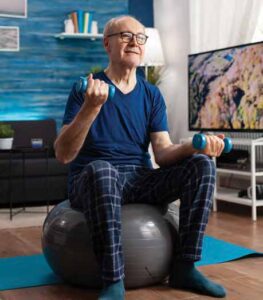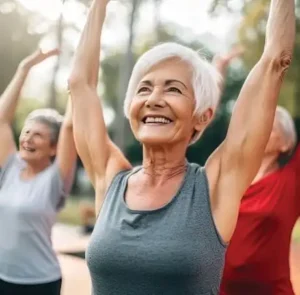
Do you routinely follow an exercise program? — Great! If not, you may want to start. Some of the benefits of regularly exercising include:
- Delaying or preventing the onset of disabilities or diseases such as diabetes, heart disease, obesity and osteoporosis.
- Reducing pain from arthritis.
- Helping with anxiety and depression through better sleep and feelings of well-being
- Reducing the risk of falls, the most common cause of nonfatal injuries in adults over age 65.
Getting Started:
Choose an activity that you’ll enjoy and can do regularly and gives the most benefit.
Take into consideration your interests, health and physical limitations, as well as the ease of accessing the activity. Kirby Pines offers a wide range of classes and a variety of equipment in the Oasis. Schedule time for your new activities: 30 minutes for 5 days quickly add up for the recommended 150 minutes of moderate exercise weekly. Incorporate four different types of activities into an exercise regimen, as they provide different health benefits:
Endurance Activities increase the heart rate and breathing. Including walking, jogging or dancing, they help improve the cardiovascular system. Try the NuStep or Bike in the Oasis.
Strength Exercise such as weight training can help build up muscles and reduce age-related muscle loss. The Oasis is fully equipped to build muscle strength, or check out Kim Roberts’ Strength classes.
Stretching Exercises help keep the body flexible and able to move easily. Yoga Stretch and Chair Yoga can make a difference.
Balance Exercises help improve balance, reducing the risk of falls. Water Aerobics and Yoga classes practice balance moves each class.
As each person has different health issues and medications, checking in with a health care provider before beginning is key to preventing injuries.
If you have any questions about the classes we offer or using the equipment, check with Kim Roberts, you will see where to find her on the schedule to the right.
SUPPORT THE ARTHRITIS FOUNDATION
Friday, April 11th – Arthritis Foundation Bake Sale

We will be having a bake sale for the benefit of the Arthritis Foundation from 10:00 am to 2:00 pm in the Lobby on Friday, April 11th. Please deliver your baked goods to the Resident Programs office the day before unless you plan to bring something delicious straight out of the oven the day of.
Tuesday, April 22nd – Arthritis Foundation Walk
Join us for the Kirby Pines annual walk for the Arthritis Foundation. We will meet in the Lobby at 10:30 am and will begin the walk around the Kirby Pines grounds at 10:40 am. Drink plenty of water and join in on the fun.























 © 2025 Kirby Pines LifeCare Community. All Rights Reserved |
© 2025 Kirby Pines LifeCare Community. All Rights Reserved | 